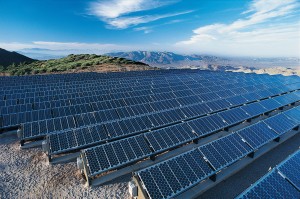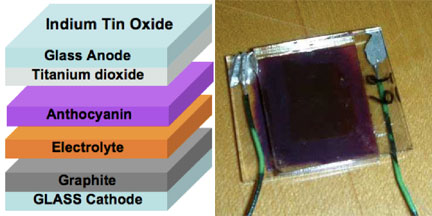Berry Organic Solar Energy
TeachEngineering.org lesson contributed by the National Science Foundation GK-12 and Research Experience for Teachers (RET) Programs, University of Houston.
Summary
Students working in teams of four learn how a device made with dye from a berries can be used to convert light energy into electrical energy by building their own organic solar cells and measuring performance based on power output.
Grade Level: 9-12
Time: 50 minutes
Engineering Connection
- Describe how energy is transferred and converted from sunlight in order to power a device.
- Define organic solar cell.
- List the benefits and drawbacks of organic solar cells.
- Define renewable energy.
- L. It is impossible to build an engine to perform work that does not exhaust thermal energy to the surroundings. [Grades 9 – 12]
- M. Energy resources can be renewable or nonrenewable. [Grades 9 – 12]
Materials List
- 1 indium tin oxide/titanium dioxide-coated plate; possible sources include the Dutch company Man Solar and the University of Washington’s Chemistry Department
- 1 uncoated glass plate, available in kit from mansolar.com
- 1 pencil
- 1 paper clip
- 2 alligator clips with wire leads
- a light source, such as a microscope lamp
- a device to power, such as a calculator, musical greeting card, or small motor
- 10 mL anthocyanin dye from black cherry concentrate, available online at amazon.com, newegg.com, or buy.com. Alternatively, the Exploratorium’s Juice from Juice activity recommends crush blackberries or raspberries in a blender or with a fork, adding 1 tablespoon of water for every 10 berries. Or simply take the juice left over after frozen berries have thawed.
- 1 Petri dish
- 10 mL iodine in potassium iodide electrolyte solution; put in small dropper bottle
- 1 small (<20mL-size) dropper bottle
- ethanol, to rinse glass plates to remove dye
Introduction/Motivation
Show students a diagram of the electromagnetic spectrum (above). The electromagnetic spectrum ranges from low-energy radio waves, such as those you use to listen to music in your car, to high-energy gamma rays, which are emitted from some radioactive elements. What part of the electromagnetic spectrum do you think the sun is emitting? (Answer: The sun emits energy from the UV to the infrared region [250–2500 nm].)
In our device, we have an organic compound called anthocyanin. We extract this compound from plants such as cherries, blackberries and raspberries, by boiling them in water and keeping the purple-red water that contains the dye. Since this compound is colored, it absorbs light. What part of sunlight would the anthocyanin be absorbing? (Answer: Green light; indicate the very small part of the spectrum that is green.) So this molecule only absorbs a tiny part of what the sun emits. In a device, the dye absorbs energy in the form of light and then the light can be turned into electrical charges in the dye, which can flow from the device in the form of electrical energy. But, not just any colored compound will do.
The conversion of light into electrical charges depends upon the chemical makeup of the dye. We chose anthocyanin because it has the right chemical properties for an organic solar cell. Anthocyanin is a small molecule only a few nanometers across. Just for a frame of reference, how thick do you think a single hair is? (Answer: About 10,000 nm thick.) Since it is so small it takes a lot of individual molecules to make a single device. In order to get as much dye as possible in our device, one of the glass slides you will receive (hold up an indium tin oxide/titanium dioxide-coated slide) is coated with indium tin oxide and titanium dioxide. This serves two purposes: the titanium dioxide is nanoporous—like a nanoscale sponge to soak up the dye—and indium tin oxide is the anode where the electrical charge will go into our device. In order to have electrical current you must have a flow of electrons. The electrons will go to the dye from the anode, but where will they go?
We will take another glass slide, one that is not coated with titanium dioxide, and cover it with graphite from a pencil. The graphite acts as the cathode, or where the electrons flow when they come out of the dye. We will also use an electrolyte to ensure good connectivity between all the components. An electrolyte is a substance that has free ions, which makes it a good conductor of electricity. Once you have constructed your device you will test the current it produces by powering different devices.
Vocabulary/Definitions
| anode: | An electrode through which electric current flows into a device. |
| anthocyanin: | An organic compound extracted from plants such as cherries, blackberries and raspberries by boiling them in water and keeping the purple-red water that contains the dye that can absorb light energy. Anthocyanins are used in organic solar cells because of their strong light harvesting, and their ability to convert this light energy into electrical energy. |
| cathode: | An electrode through which electric current flows from a device. |
| electrolyte: | A substance with free ions that is electrically conductive. |
| nonrenewable energy: | Energy that cannot be replaced in less time than it takes to be consumed, for example, coal, oil, natural gas |
| organic: | A compound that contains the element carbon. |
| renewable energy: | Energy that automatically replenishes itself from ongoing natural processes, for example, energy from the sun, wind, water, biological, geothermal. |
| solar cell: | A device that converts sunlight directly into electricity. |
- Gather and assemble materials needed for each group.
- Fill a Petri dish with enough anthocyanin to submerge a slide.
- Prepare a small dropper bottle with iodine in potassium iodide electrolyte solution.
- Keep the Petri dish and dropper bottle at the teacher’s desk.
- Demonstrate each step for students before allowing them to begin (refer to the above diagram).
- Divide the class into groups of four students each.
- Have one student from each group prepare the anode by soaking the titanium dioxide-coated plate in the anthocyanin dye for 5 minutes.
- While the anode is being prepared, have another student in each group prepare the cathode by thoroughly covering one side of the uncoated glass slide with graphite from a pencil.
- With the cathode graphite-side up, have each student add 2 drops of electrolyte solution to it (refer to Figure 3).
- Place the anode titanium dioxide down on top of the cathode (see diagram). Slightly offset the glass plates, and paper clip the glass plates together.
- Connect one alligator clip to the anode and the other to the cathode to complete the circuit with your device. Observe.
- Combine devices with other groups’ in a series to power more devices.
- Have students note the temperature of the devices after use.
- Disassemble the devices and rinse the glass plates with ethanol to remove dye.
- Conclude by having students prepare summary lab write-ups, as described in the Assessment section.
Safety Issues
- Iodine and dyes may stain so use caution when handling.
- Glass slides are fragile so handle with care.
Troubleshooting Tips
Investigating Questions
Assessment
- What is renewable energy?
- What is an electrical circuit?
- What has more energy, gasoline or sunlight? Why?
- What is that piece called?
- What is the purpose of (the dye, the glass, the alligator clip, etc.)?
- How does the device work if it is cold outside? (Answer: This is a photovoltaic cell. It converts light to electricity. It does not convert heat to electricity. A device that converts heat to electricity is called a solar thermal cell. A photovoltaic cell works the same on a cold day as a hot day, but it does not work as well on a cloudy day as on a bright day.)
- What happens if (you leave out a piece, you disconnect something, you change the order assembly, etc.)?
- What electrical devices were you able to operate?
- Did your device work?
- What did you observe?
- How did your device compare to others?
- Is this an effective way to power things?
- Why did your device perform well/not perform?
- How could you have improved your device?
Activity Scaling
- For lower grades, conduct this activity as a demonstration only.
- For upper grades, provide students with multimeters to measure current and voltage output, and give them more variables to test to optimize device performance.
Resources
Juice from Juice! This well-illustrated activity developed by San Francisco’s Exploratorium Teacher Institute guides students through the process of building a solar cell from blackberry or raspberry juice, with an explanation of what’s happening.
Titanium Dioxide Raspberry Solar Cell. Step by step lab from the University of Wisconsin’s Materials Research Science and Engineering Center, with . [See YouTube demonstration: https://www.youtube.com/watch?v=Jw3qCLOXmi0]
Dye-sensitized Solar Cell Module: Using organic dyes to generate electricity from light. Hands-on lesson and teachers’ manual developed in conjunction with the Center for the Advancement of Mathematics and Science and Education at Black Hills State University in South Dakota.
Dye-sensitized solar cells. Grätzel, Michael. Journal of Photochemistry and Photobiology, October 31, 2003. C: Photochemistry Reviews, Volume 4, Issue 2, pages 145-153.
Solar Cells Fake Photosynthesis Using Berry Juice. PhysicsBuzz blog post about the novel device that won Michael Grätzel Finland’s prestigious Millennium Technology Prize in 2010.
Man Solar. The largest worldwide supplier of turnkey solar cell kits, including educational kits and materials for the preparation of dye-sensitized solar cells, which mimic photosynthesis of green plants. Good information on the website, too.Harnessing Solar Energy with Grätzel Cells. Mortimer, Roger J. and David R. Worrall. September 2007 issue. Department of Chemistry, Loughborough University, Loughborough, Leicestershire. Education in Chemistry, Royal Society of Chemistry. Includes good photos and diagrams of a similar lab.
Nanocrystalline Solar Cell Kit with materials for five reusable cells (order #98-001). Also replacement parts (extra glass slides, kit components and parts). Hands-On Science Kits and Demos, Institute for Chemical Education (ICE), Department of Chemistry, University of Wisconsin-Madison.
Looking to the Heavens: Climate Change Experiments. Shallcross, Dudley, Tim Harrison, Steve Henshaw and Linda Sellou. August 12, 2009. Science in School, EIROforum, Issue 12. Source for background information; good photos and diagrams of lab; good information about Grätzel cells and energy from sunlight.
Transparent solar cells could turn every window into a power source. Michigan State University engineering researcher develops the first fully transparent solar cell. (ExtremeTech blog post, April 20, 2015).
Contributors
Crystal Young
Copyright
© 2013 by Regents of the University of Colorado; original © 2011 University of Houston
Supporting Program
National Science Foundation GK-12 and Research Experience for Teachers (RET) Programs, University of Houston
Filed under: Class Activities, Grades 9-12, Grades 9-12, Lesson Plans
Tags: Alternative Energy, berry, Chemical Engineering, Class Activities, curcuits, electrical circuits, Electrical Engineering, electricity, Grades 9-12, materials, organic, Solar Energy, Sustainability













